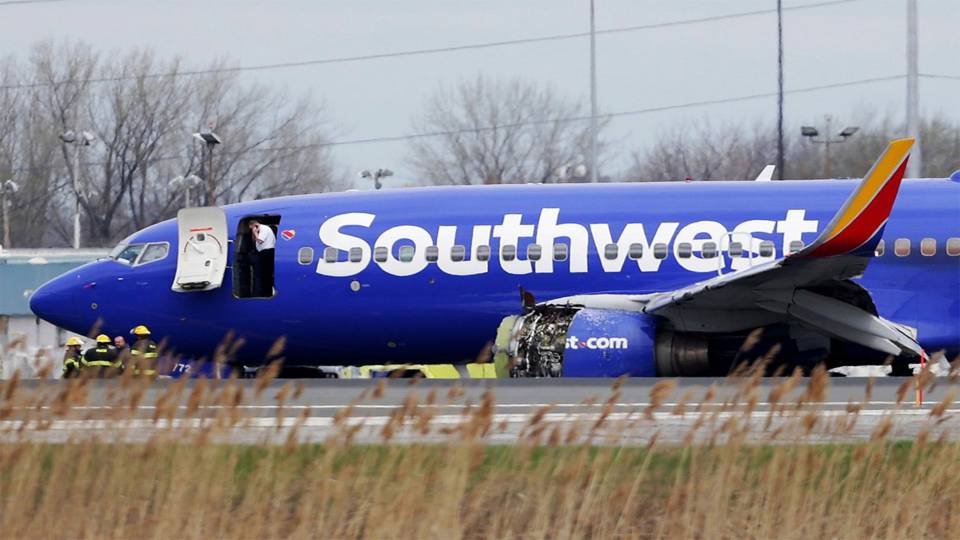‘Panic Just Ensues’: Inside Southwest’s Fatal Midair Engine Failure
A passenger on a Southwest Airlines Co. flight died Tuesday after an engine broke apart at more than 30,000 feet, spraying metal pieces through the fuselage and forcing the crippled jet to make an emergency landing.
It was the first fatality from a U.S. airline accident since 2009.
Details of what happened to Flight 1380 and why metal pieces from its left engine were hurled into cabin—apparently rupturing a window behind the wing and fatally injuring a passenger seated nearby—weren’t expected until investigators examine the plane and interview the crew.
The passenger killed was Jennifer Riordan, who worked as a community-relations leader for Wells Fargo & Co. in New Mexico and was a married mother of two children, her sister-in-law, Marianne Riordan, said in an interview.
Witness reports, videos and preliminary information gathered by federal officials suggest the Boeing 737-700 suffered the most serious and rare type of engine problem, called an uncontained failure, in which rapidly spinning parts break off and end up penetrating the engine’s outer casing and front cover.
The accident happened at cruising altitude, according to people familiar with the sequence of events, after the jet left New York’s LaGuardia Airport for Dallas. The plane, carrying 144 passengers and five crew members, made an emergency landing at around 11:27 a.m. in Philadelphia.
Passengers described a chilling scene of chaos. Marty Martinez had just pulled out a book to read when he heard a loud boom. Within seconds, oxygen masks dropped down. Shrapnel from the burst engine slammed against a window a few rows in front of him and broke it open, he said.
“Panic just ensues,” said Mr. Martinez, the 29-year-old owner of a digital marketing agency in Dallas who was in New York for business. “Now the entire plane is shaking. Air was being sucked out of the cabin. People started screaming.”
He said a woman seated where the window burst suffered injuries and passed out. Other passengers were holding on to her body to keep her from getting sucked out the opening.
The plane tilted to the right, so that Mr. Martinez could see the ground below outside his window. It shook violently as it descended, worse than any turbulence he had ever experienced before, he said.
Diana Self, an insurance agent with Texas Farm Bureau who had been in New York with her husband on a business trip, said he tried to calm down people sitting around them who were panicking.
“The screaming was horrific,” Ms. Self said. She described seeing a passenger pulled to the window as other passengers tried to grab and hold on to her; the force ripped the woman’s top off, Ms. Self said. “It was something you wish you could unsee or experience.”
The National Transportation Safety Board hasn’t said how the passenger was killed. One theory, according to a person familiar with the matter, is that she was struck by pieces of the crippled engine that came in through the plane window.
Mr. Martinez, the digital agency owner, said that amid the mayhem he bought Wi-Fi service so he could reach out to loved ones. He struggled to keep his focus, entering his credit card information digit by digit.
When he finally logged on, he began broadcasting his video image on Facebook Live, an oxygen mask covering his face. “It appears we are going down! Emergency landing!!” he wrote.
One person familiar with the sequence of events said a fan blade in the engine separated and bored a hole in the nearby fuselage. Other high-energy parts penetrated different parts of the plane’s skin and damaged the front edge of the left wing, as some pieces were carried over the wing, this person said.
Parts of the fuselage near the damaged window had a pink tinge, suggesting a spray of blood from the passenger sitting in that seat, said a person familiar with the sequence of events.
The NTSB dispatched a team of about a dozen investigators led by board Chairman Robert Sumwalt to the scene.
Mr. Sumwalt said the cockpit voice and flight data recorders were expected to be downloaded, and preliminary information could be gleaned as quickly as Tuesday evening.
The accident is the first fatal one involving a U.S. airline since 50 people died in February 2009 when a commuter plane operated by Colgan Air, a partner of what was then Continental Airlines, crashed near Buffalo, N.Y.
It is the first fatality involving a Southwest plane since 2005, when one of the airline’s 737s hurtled off a runway on landing at Chicago’s Midway airport and collided with vehicles on a road, killing a 6-year-old. Southwest operates more than 700 Boeing 737 jets.
{Snip}






















